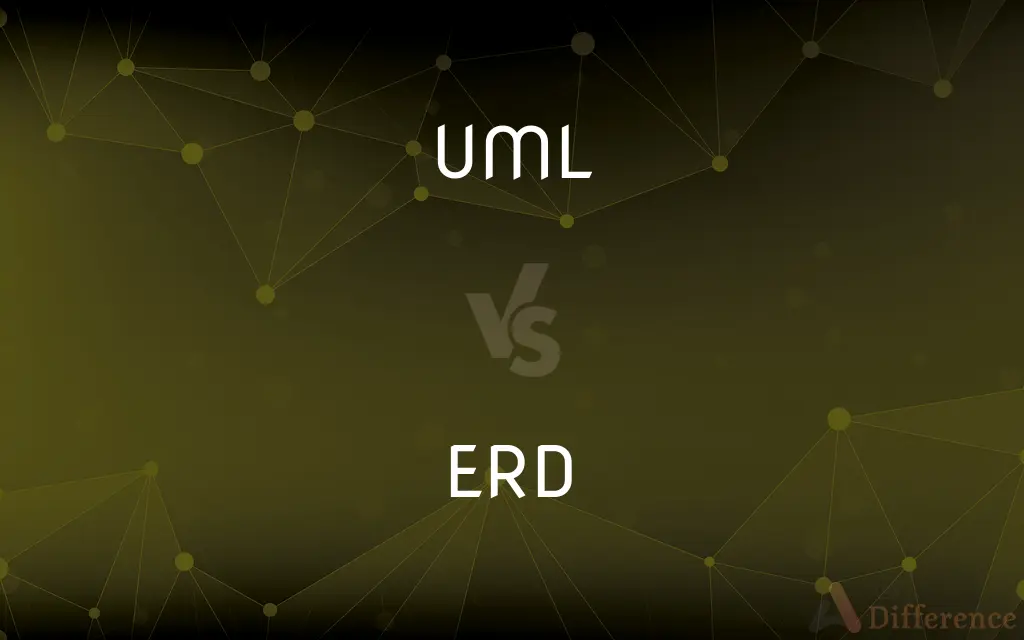UML vs. ERD — What's the Difference?
By Tayyaba Rehman — Published on December 24, 2023
UML (Unified Modeling Language) is a standardized modeling language enabling system and business architecture visualization, while ERD (Entity-Relationship Diagram) is specific to illustrating database relationships.

Difference Between UML and ERD
Table of Contents
ADVERTISEMENT
Key Differences
UML, or Unified Modeling Language, is a versatile modeling language used in software engineering, providing a standard way to visualize the design of a system. ERD, or Entity-Relationship Diagram, on the other hand, is a type of diagram used specifically to showcase the relationships between data stored in a database. Both serve different purposes in the realm of system design, with UML offering a broader scope and ERD focusing specifically on databases.
In terms of utility, UML is a comprehensive language that covers structural, behavioral, and interaction aspects within a system, making it applicable across various stages of software development. ERD, meanwhile, is used predominantly for database design, clarifying data structures and their relationships, but does not encompass wider system interactions or behaviors.
UML is a multi-purpose tool that can be used throughout the software development life cycle. Its various diagram types, such as class diagrams, use case diagrams, and activity diagrams, cater to different needs and stages of the development process. In contrast, ERD is used primarily in the conceptualization, design, and documentation of databases, mapping out the various entities within a system and the relationships between them.
The versatility of UML means it finds utility in business processes and system behaviors, capturing complex scenarios and workflows. ERD's strength lies in its simplicity and specificity, primarily modeling the data and its inter-relationships within a system, making it an essential tool in ensuring database efficiency and accuracy.
From a notation perspective, UML offers a standardized and highly structured notation, utilizing a wide range of symbols to represent different types of information and their relationships. ERD uses rectangles to represent entities, and diamonds to depict relationships, ensuring clarity in representing database structures. While UML's complexity allows for detailed system modeling, ERD's simplicity makes it accessible and straightforward for database design.
ADVERTISEMENT
Comparison Chart
Primary Use
System architecture and business modeling.
Database structure modeling.
Scope
Comprehensive, including various aspects of systems.
Specific to databases.
Diagram Types
Multiple (class, sequence, use case, etc.).
One primary type.
Complexity
More complex with standardized notations.
Simpler, focused on entities and relationships.
Application Stage
Throughout software development lifecycle.
Mainly in database design phase.
Compare with Definitions
UML
An industry-standard way to visualize system designs.
They adopted UML to maintain consistency with international development standards.
ERD
A tool used in computing to visually represent data or variables and their relationships.
With the ERD, we identified a redundant relationship that was complicating queries.
UML
A standardized language used to visualize the design of systems.
The team used UML diagrams to map out the new software's architecture.
ERD
A visual representation of a database's entities, attributes, and relationships.
Thanks to the ERD, they avoided several potential inconsistencies in the database's design.
UML
A tool for specifying, constructing, visualizing, and documenting the components of a software system.
UML was integral in understanding the complex relationships between different parts of the app.
ERD
A graphical technique for modeling data in a structured and organized manner.
The clarity of the ERD helped stakeholders understand the data structure without technical jargon.
UML
A language providing a set of standard notations for software diagrams.
Through UML, developers ensured they were all on the same page regarding software structure.
ERD
A conceptual data model that outlines the relationships between different types of information.
The ERD was crucial in understanding how customer data was interconnected.
UML
A modeling language that allows for an abstract representation of a system, theoretically independent of the hardware or software.
Using UML, they created a detailed model of the logical operations before commencing with coding.
ERD
A diagram that displays the relationships between different data entities in a database.
The database designer began with an ERD to lay out the primary entities and relationships.
ERD
Tlb|en|dialect|rare}} {{alternative form of earth
ERD
(zoology) The common European shrew (Sorex vulgaris); the shrewmouse or erd shrew.
ERD
The earth.
Common Curiosities
What does ERD represent?
ERD represents the entities within a system and the relationships between them, primarily used for database design.
Can UML be used for database design?
Yes, UML can be used for database design, but it's broader and includes various types of diagrams for different system aspects.
How about ERD? What does it represent?
ERD stands for Entity Relationship Diagram.
What is UML used for?
UML is used for visualizing, specifying, constructing, and documenting the artifacts of a software-intensive system.
What does UML stand for?
UML stands for Unified Modeling Language.
Are there different types of UML diagrams?
Yes, there are several types of UML diagrams, including class, sequence, and use-case diagrams.
Can ERD capture dynamic behavior like UML?
No, ERD primarily captures static data structure, whereas UML can depict both static structures and dynamic behaviors.
What is the primary purpose of UML?
UML is used to visualize, specify, construct, and document the artifacts of a software system.
And what is ERD mainly used for?
ERD is used to represent the logical structure of a database.
Can UML be used in database design?
While UML is primarily for software design, it can be adapted for database design, but ERD is more commonly used for this purpose.
How do UML and ERD relate to software development?
UML aids in software design and understanding system behavior, while ERD focuses on the data and its relationships within the system.
Is UML standardized?
Yes, UML is standardized by the Object Management Group (OMG).
Are UML diagrams and ERDs interchangeable?
No, while both depict structures, they serve different purposes and have distinct notations.
Which is older, UML or ERD?
ERD concepts predate UML, which was developed in the 1990s.
Is ERD specific to any particular type of database?
No, ERD can be used for both relational and non-relational databases.
Who typically creates ERDs in a project?
Database designers or data architects usually create ERDs.
Share Your Discovery

Previous Comparison
Gauss Law vs. Coulomb Law
Next Comparison
NTFS vs. FATAuthor Spotlight
Written by
Tayyaba RehmanTayyaba Rehman is a distinguished writer, currently serving as a primary contributor to askdifference.com. As a researcher in semantics and etymology, Tayyaba's passion for the complexity of languages and their distinctions has found a perfect home on the platform. Tayyaba delves into the intricacies of language, distinguishing between commonly confused words and phrases, thereby providing clarity for readers worldwide.













































